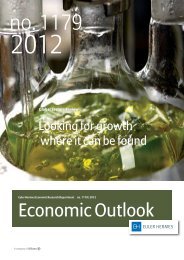Reindustrialization in USA - Euler Hermes
Reindustrialization in USA - Euler Hermes
Reindustrialization in USA - Euler Hermes
You also want an ePaper? Increase the reach of your titles
YUMPU automatically turns print PDFs into web optimized ePapers that Google loves.
<strong>Euler</strong> <strong>Hermes</strong>Economic Outlook n° 1187 | Special Report | The <strong>Re<strong>in</strong>dustrialization</strong> of the United StatesReason #1Lower labor costsThe comb<strong>in</strong>ation of high output, productivityand profitability, and low unit labor costs lays asolid foundation for cont<strong>in</strong>ued strength <strong>in</strong> theU.S. manufactur<strong>in</strong>g sector. This section analyzesthe positive contribution of fall<strong>in</strong>g labor coststo U.S. competitiveness. We argue that thiscont<strong>in</strong>u<strong>in</strong>g trend will be a major determ<strong>in</strong>ant of there<strong>in</strong>dustrialization momentum. This performancerelative to Ch<strong>in</strong>a and Europe, for <strong>in</strong>stance, must becultivated. However, a too conservative U.S. wagepolicy and low labor pric<strong>in</strong>g could eventually capproductivity ga<strong>in</strong>s and human capital accumulation,especially for niche <strong>in</strong>dustries.Competitiveness: advantage U.S.A.u As shown <strong>in</strong> Figures 12 and 13 below, compar<strong>in</strong>gU.S. trends regard<strong>in</strong>g manufactur<strong>in</strong>g productivityand unit labor cost with the other lead<strong>in</strong>g <strong>in</strong>dustrializedcountries underscores America’s enviable position.Indeed, U.S. manufactur<strong>in</strong>g has dramaticallyre<strong>in</strong>forced its productivity over the last decade andcut its unit labor costs by more than 10% (on U.S.$basis). In contrast sharply with its global competitors,it should be noted that the fall<strong>in</strong>g U.S. dollar versusthe euro may have contributed to the difference.Additionally, from 2000-2010 manufactur<strong>in</strong>g productivity<strong>in</strong> the U.S. has grown at an annual rate of5.2%, greater than most <strong>in</strong>dustrialized nations exceptfor the rapidly emerg<strong>in</strong>g economies of Taiwan, theCzech Republic, and South Korea. At the same time,the U.S. has been one of only two major countrieswhere manufactur<strong>in</strong>g unit labor costs have actuallyfallen. While this is a significant competitive advantage,it arises from the fact that productivity hasgrown sharply while real wages have hardly changedat all.12. Manufactur<strong>in</strong>g Labor ProductivityIndex basis 100 = 200213. Manufactur<strong>in</strong>g Labor CostsIndex basis 100 = 200216Source: Bureau of Labor Statistics, <strong>Euler</strong> <strong>Hermes</strong>Source: Bureau of Labor Statistics, <strong>Euler</strong> <strong>Hermes</strong>












